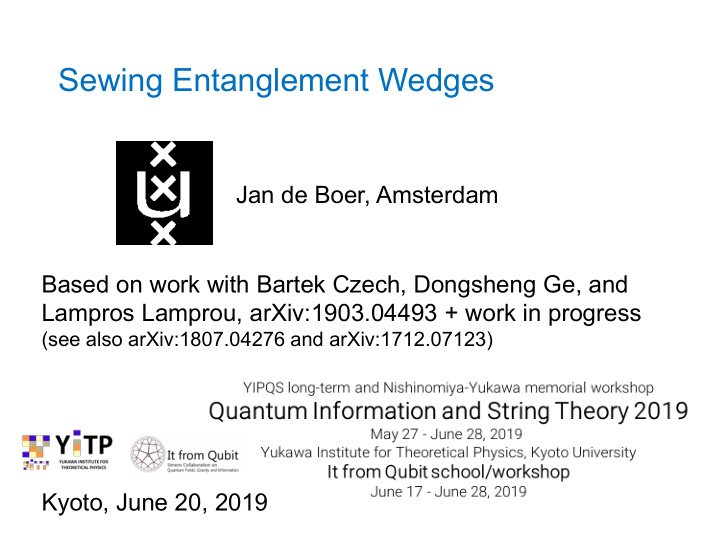



Sewing Entanglement Wedges Jan de Boer, Amsterdam Based on work with Bartek Czech, Dongsheng Ge, and Lampros Lamprou, arXiv:1903.04493 + work in progress (see also arXiv:1807.04276 and arXiv:1712.07123) Kyoto, June 20, 2019
Recent work has uncovered interesting relations between: • Various notions of quantum information theory • Algebraic QFT • Chaos • Shock waves • Energy Conditions • Bootstrap methods • Bulk reconstruction • Constraints on semiclassical gravitational backgrounds Here, by thinking about a notion of parallel transport for entanglement wedges/modular Hamiltonians we will run into another set of such connections..
In general relativity, parallel transport provides a way to compare tangent vectors or frames at different points. Freely falling observers accomplish parallel transport picture from wikipedia
It would be nice to generalize this to (local) states and observables in order to compare different observers. Symmetries? Connection to spacetime ↔ entanglement ER=EPR ….?
Toy example in quantum mechanics: Assume for simplicity are maximally mixed. But unless we correlate the two unitaries in a precise way.
So in this case: • Entanglement connects the bases in A and B • W transforms like an open Wilson loop under the local symmetries • W yields an anti-unitary map from A to B. This maps operators in A to mirror operators in B ( cf Papadodimas- Raju ) and automatically relates bases in the right way. • Using W to go from A to B and another W’ to go back from B to A results in a non-trivial holonomy.
Plan: use these ideas to study parallel transport for a family of entanglement wedges in AdS/CFT. boundary bulk
What are the symmetries? Boundary : Unitaries that preserve the state, or equivalently, the modular Hamiltonian Using JLMS ( Jafferis, Lewkowycz, Maldacena, Suh ) Bulk : Diffeomorphisms that preserve the entanglement wedge, the area, and leave invariant.
Boundary diagonal U is ambiguous up to unitaries that leave invariant. Generically U(1) d . Under infinitesimal change Parallel transport = particular choice of (flatness condition)
Proposal: parallel transport is defined by requiring that does not possess a modular zero mode
Proposal: parallel transport is defined by requiring that does not possess a modular zero mode zero mode
Proposal: parallel transport is defined by requiring that does not possess a modular zero mode zero mode zero mode
More generally, is the connection for parallel transport: If then obeys the parallel transport condition.
These equation may look peculiar, but are nothing but a generalization of the Berry phase: Take then project usual Berry connection
Example 1: 2d CFT with intervals etc
then This reproduces the results of Czech, Lamprou, McCandlish and Sully. In particular, the holonomy is related to differential entropy.
Example 2: modular inclusions ( Casini, Teste, Torroba ) connection
Bulk picture What are the relevant symmetries? The bulk modular Hamiltonian becomes approximately a boost near the minimal surface. Will take the point of view of “surface symmetries”, “edge modes”, “asymptotic symmetry group”, etc (cf Donnelly, Freidel; Camps )
Consider a minimal surface Choose coordinates Modular Hamiltonian is boost in transversal plane
Symmetries: Preserve asymptotic form of metric, have non-trivial charges, and commute with modular Hamiltonian vector field. Two components: diffeomorphisms along surface and location-dependent frame rotations. Microscopic interpretation? Only visible in code subspace?
Parallel transport should provide: • a relation between the coordinates y of nearby minimal surfaces • a relation between choices of orthonormal bases for the normal plane One can repeat analysis: where on minimal surface
Qualitative picture: To transport a point on a minimal surface to a point on a nearby minimal surface: separation should be orthogonal to the minimal surfaces To transport normal frame: parallel transport in orthogonal direction and project into new normal plane
Holonomy: surface diffeomorphism + frame rotation
Surface diffeomorphism illustrated
Red dot gets displaced by circumference of circle. Can use this to reconstruct length of curves. ( Balasubramanian, Chowdhury, Czech, JdB, Heller )
Interpretation of frame rotation? Closely related to bulk curvature. Consider e.g. 2d case where minimal surfaces are points. Procedure reduces to ordinary parallel transport of tangent vectors, and curvature of connection = geometric curvature. Connection to curvature only clear in case For AdS3, boundary discussion can be directly translated into bulk (symmetries=Killing vectors) and agrees with above picture.
Examples show that there are special situations in which In the bulk, these correspond to deformations in light cone directions. One can think of these vector fields as “shock waves”
In the bulk, these modes always exist. But what about the boundary theory? Conjecture: If then . This is closely related to the bound on chaos. If there is a semiclassical gravitational dual the bound is saturated. cf modular chaos of Faulkner, Li, Wang • holds for Virasoro deformations of AdS3 • holds for inclusions of operator algebras • does not hold in higher spin theories in AdS3 – maximal value of agrees with result of Perlmutter
The “shock wave” vector fields have an interesting commutator which is similar to the expression for Planckian scattering found by ‘t Hooft; Verlinde, Verlinde … Key in this computation is to pick the right vector fields, i.e. where the modular zero mode has been projected out.
Many questions: • General interpretation of the curvature/holonomy? • (dis)prove conjecture • Clarify the precise relation to chaos and shockwaves • Connect to recent work on shock waves ( Kologlu, Kravchuk, Simmons-Duffin, Zhiboedov; Belin, Hofman, Mathys ) • Connection to other recent appearances of the Berry connection? ( Belin, Lewkowycz, Sarosi ) • Connection to bulk reconstruction? ( Faulkner, Li, Wang; Kabat, Lifschytz ) • Useful to get a handle on the code subspace? • Connection to recent discussions of soft hair? (…) • Include other fields (e.g. gauge fields) with non-trivial edge modes? • Generalize to other spacetimes? • Can we get dynamics in this framework? • Applications to two-sided case?
Recommend
More recommend